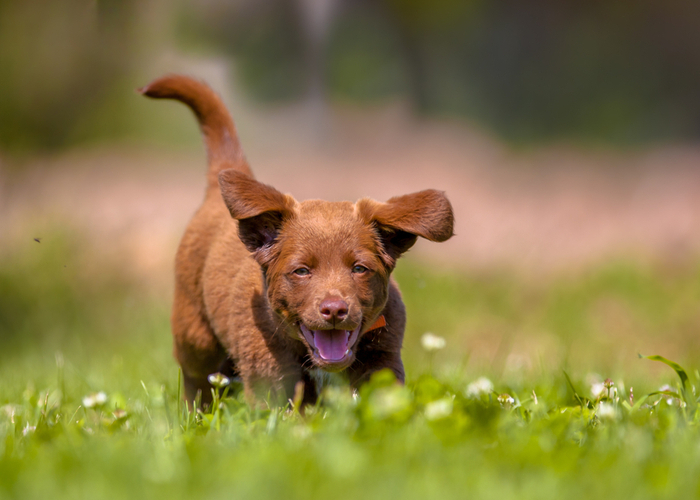
Table of Contents
Spring is a time of rejuvenation and new beginnings, but it can also bring unique challenges, especially for dog owners.
As the weather warms up and breathes life into everything, it's crucial to prioritize your pet's health and well-being.
That's why we've put together a comprehensive guide to help you care for your dog during the spring season.
From grooming tips to health and safety considerations, nutrition advice, and travel-related queries, we've got you covered.
Our practical and actionable advice will help ensure your furry friend stays happy, healthy, and protected during this vibrant time of the year.
So, let's dive in and discover how you can give your dog the care they deserve this spring!
How To Care for Your Dog During Spring

Look Good To Feel Good!
It is no surprise that taking care of our physical appearance can have a drastic effect on our psychological well-being.
It creates mental clarity and helps us feel good about ourselves and our world. The same goes for your pet.
Being mindful of your pet’s grooming needs will help them look and smell their best, maintaining the loving bond you two share!
Brushing
Did you know that spring is regarded as the shedding season for dogs?
This means winter is over, and your canine friend's fur may fall out to make space for the coming summer heat ahead.
While that is a natural phenomenon that keeps their body temperature in check, it can also mean random dog hair floating in the air or even on your clothes and furniture, etc.
While brushing won't reduce hair fall, it can help remove all loose hair and stick it into the brush.
Then you can take them out and dispose of them instead of carrying a lint roller wherever you go.
We recommend brushing your furry friend's hair at least once or every other day for optimum results.
But you may give more gaps if your dog's hair is naturally short and doesn't shed much.
Bathing
Bathing is another essential component during springtime.
Your dog will go outdoors to play, rolling around in the mud and perhaps getting into not-so-clean areas.
This may mean an increase in the frequency of baths as springtime approaches.
Generally, we recommend bathing your dog every 4-6 weeks to stay clean and fresh.
But it may also vary depending on your dog's breed, size, and activity level.
We suggest consulting a veterinarian or a professional groomer for personal recommendations regarding the frequency or procedure for bathing your specific dog.
Nail Trimming
During springtime, your dog plays outdoors and comes in contact with hard surfaces such as concrete and pavements.
This can cause their nails to break off earlier and be more painful than what would’ve been natural.
This is why frequently trimming your dog’s nails can be fundamental for their overall health and performance during springtime.
We recommend trimming your pet’s nails every 4-6 weeks to help them stay a suitable length.
Overgrown nails can cause discomfort, pain, and even injury.
They should stay within an appropriate length to prevent harming your dog (and even property, such as your furniture, etc.)
ALSO READ: Nail Neglect: Importance of Dog Nail Trimming

Healthy Dog, Happy Life
Health is a crucial component of every living thing. It is necessary for survival and helps us feel, live, and perform at our best.
The same goes for your dog.
A strong and thriving dog means less stress, minimal visits to the vet, and more hearty time with each other!
Here, we have compiled a list of things to look for during spring-time for a well-kept and robust pet:
Seasonal Allergies
Spring brings nature into full vigor. But, it also brings pollen, which causes several seasonal allergies in dogs.
These could be excessive scratching, biting, chewing, rubbing, sneezing, runny nose, ear infections, etc.
We recommend increasing your dog’s exposure to the outdoors and gradually contacting a veterinarian immediately if your pet shows any sign of the abovementioned discomfort.
Click here to learn more about seasonal allergies, diagnosis, symptoms, and prevention.
Parasite Prevention
Fleas and Ticks
Another concern during springtime is fleas and ticks prevention.
These pests can seriously threaten dogs by transmitting diseases, including Lyme disease, Rocky Mountain spotted fever, ehrlichiosis, etc.
We suggest using medicated topical collars recommended by a professional and checking your pet’s fur for fleas and ticks, especially after being outdoors.
Heartworms
Heartworms also pose a threat to your dog's health during springtime.
These are transmitted through the bite of an infected mosquito and are lethal if left untreated.
Common symptoms include persistent coughing, fatigue, decreased appetite, weight loss, and difficulty breathing.
Severe cases may include experiencing fainting, seizures, and even death.
So, taking your canine friend to a veterinary professional immediately is recommended if you notice the symptoms.
Remember: An early diagnosis can mean an early recovery.
Exercise
Physical and mental stimulation is integral to keeping your dog healthy and thriving.
The moderate and pleasant weather during springtime offers a wonderful opportunity to spend time outdoors.
This includes activities such as walking or hiking, playing fetch, swimming, etc. This will help your pet release that pent-up energy while keeping them in shape!

Safety First!
Springtime brings beauty, colors, and vibrance. The blossoming flowers rejuvenate our faith, and the moderate sunlights help ignite our zest for life.
But, as pet parents, it also brings a set of responsibilities for us regarding safety.
This is because of the dangerous and toxic substances that can pose a threat to our playful canine friends.
Here is how to take care of your dog and keep them well-protected during springtime:
Hazardous Substances
Spring usually entails a deep-cleaning procedure at our homes.
This structural procedure can be messy and include the changing position of sharp, unsafe, and dangerous substances, such as rodenticides and insecticides from under our sinks or medications from our cabinets.
As a pet parent, you must ensure that no such object lies in a place where it may be accessible to your curious pet.
You may also take your energetic dog on his daily walks and playtime.
This may expose them to flowers and plants that are toxic to dogs, such as daffodils, sago palms, tulips, azaleas, etc.
You must ensure that your dog stays away from them and doesn’t go around smelling them while you’re at it.
We recommend contacting a veterinarian professional immediately in case of accidental ingestion.
Weather
Another concern during springtime is the changing weather. The gloomy winters are over, and the sun is finally up.
But, as enticing as it may be, don’t spend too much time outdoors simultaneously.
Take your time adjusting to the weather and increase your exposure gradually.
This will help decrease the risk of heatstroke your dog may be susceptible to without proper caution.
Outdoor Safety
Generally, all places have certain local leash laws to ensure public safety and prevent dogs from causing harm or damage.
That is another safety concern you must be mindful of during your dog's daily walks.
Your canine companion may encounter certain wildlife while exploring escapades. These include birds, rabbits, squirrels, skunks, and snakes.
Since dogs are domineering by nature, they may fight with these, which may be dangerous.
This is why we recommend having a command that will immediately bring them to you, avoiding potential animal-to-animal combats.

Fuel Your Pet with Good Nutrition
Good nutrition is essential all year round. But building sufficient immunity against disease-causing pathogens during spring can be incredibly crucial.
The healthier your pet's diet, the more likely they'll have the nutrients to survive potential health concerns.
It will also help provide sufficient energy to play outdoors with other pets amongst the blossoming flowers and shady trees.
Foods to Eat
We recommend incorporating the following foods into your dog’s dietary routine for a balanced and nutrients rich diet:
- Foods rich in lean proteins, such as chicken, turkey, fish, and lean cuts of beef.
- Fresh vegetables and fruits include carrots, peas, green beans, asparagus, strawberries, and blueberries.
- Whole grains, such as brown rice and quinoa.
- Probiotics through yogurt, kefir, and fermented vegetables like sauerkraut.
- Adequate amount of water to ensure your pet is hydrated throughout the day.
Foods to Avoid
Much like foods to eat, there are also eatables your pet should not consume during spring (or any other time, for that matter).
These include grapes, raisins, and Xylitol products, such as sugar-free gum, candy, and baked goods.
Since Easter is just around the corner during spring, it is also important that you hide all forms of chocolate away from your dog.
All these foods are toxic for dogs and can cause symptoms such as vomiting, diarrhea, restlessness, increased urination, tremors, seizures, and even death in severe cases.
As a pet parent, it is your responsibility you ensure all these foods are stored in a place inaccessible to your curious four-legged friend.
Healthy Treats
Spring can be a wonderful time to teach your dog fun and exciting tricks. It is neither too cold nor too warm.
You and your dog will have the ideal mind and spirit to learn amusing and exhilarating stunts.
We already know the efficacy of treats during such training. But, some dogs are more susceptible to weight gain due to their breed and size.
So, we recommend only healthy dog treats to ensure they stay fit and feel their best!

Embark on a Spring Adventure With Your Furry Friend!
Spring is a wonderful time to bask in the sun and enjoy the picturesque views of the blossoming flowers.
What better way to maximize its glory than hitting the road and delighting in the joys of dog-friendly travel destinations out there?
Enjoy a splendid getaway from daily life, and your energetic dog will love exploring this season's vibrant colors and musical sounds.
Planning a Trip
Did you know that the world has surrendered to the love for dogs, and there are parks with dog-friendly trails, swimming pools, off-leash fenced areas, and even pet restaurants now?
Yes, you heard that right!
We recommend visiting the world’s biggest dog parks to explore the stunning views and pleasant weather.
Exercise is crucial for a dog’s physical and psychological well-being.
The wide expanse of beautiful scenery and dog-friendly accommodations here will be perfect for you and your furry friend to escape from the hustle and bustle of everyday life and have an exciting time with each other.
Travel Essentials
Before you head out to have the time of your life, don’t forget to pack some of the travel essentials that will ensure your dog’s health and safety. These include:
Pet ID Tags and Microchips
Dogs are explorers at heart, and spring's various sights and sounds may call out to them. This means it may run away while you aren't looking.
Having an electronic chip between his shoulder blades increases the chances of your pet being identified and returned to you in case that happens.
First Aid Kit
Your pet can get injured while playing or even trekking up that scenic hill with you.
Having a pre-assembled first-aid kit with you means you can tend to the wounds as early as possible.
So, whether it’s a bandage or medication, your pet can be restored to optimum health and enjoy the rest of the journey.
Car Safety
Traveling with a dog can be challenging.
You must be mindful of road safety while ensuring that your pet has ample space to live and breathe without threatening your driving.
For example, your furry friend's instinctive curiosity may lead to them attacking the steering while you're just trying to drive.
This is why we recommend carriers, crates, or seat belts, at the very least, to minimize the likelihood of unsafe accidents.
Dog crates and carriers come in all shapes and sizes, and they're an effective method of securing your dog in one place while you reach your destination.
On the other hand, seat belts are equally efficacious, provided that you secure your furry friend safely.
It should be loose enough for comfort while also being enough to minimize potential movements.
How To Care for Your Dog During Spring: Final Words
Taking care of your dog during springtime can be challenging, but with the right advice and precautions, everything is possible.
All you need to do is set up a to-do list and tick off the boxes as you go.
While it may seem intimidating at the start, it will get easier and simpler as you progress.
Remember: you are doing the best you can, and with some extra effort, your pet can lead a happier and healthier life.
And, while you’re at it, don’t forget to catch a break and take care of yourself too.
This will help improve the bond you two share, ensuring a lifetime of love, adoration, and memories!












